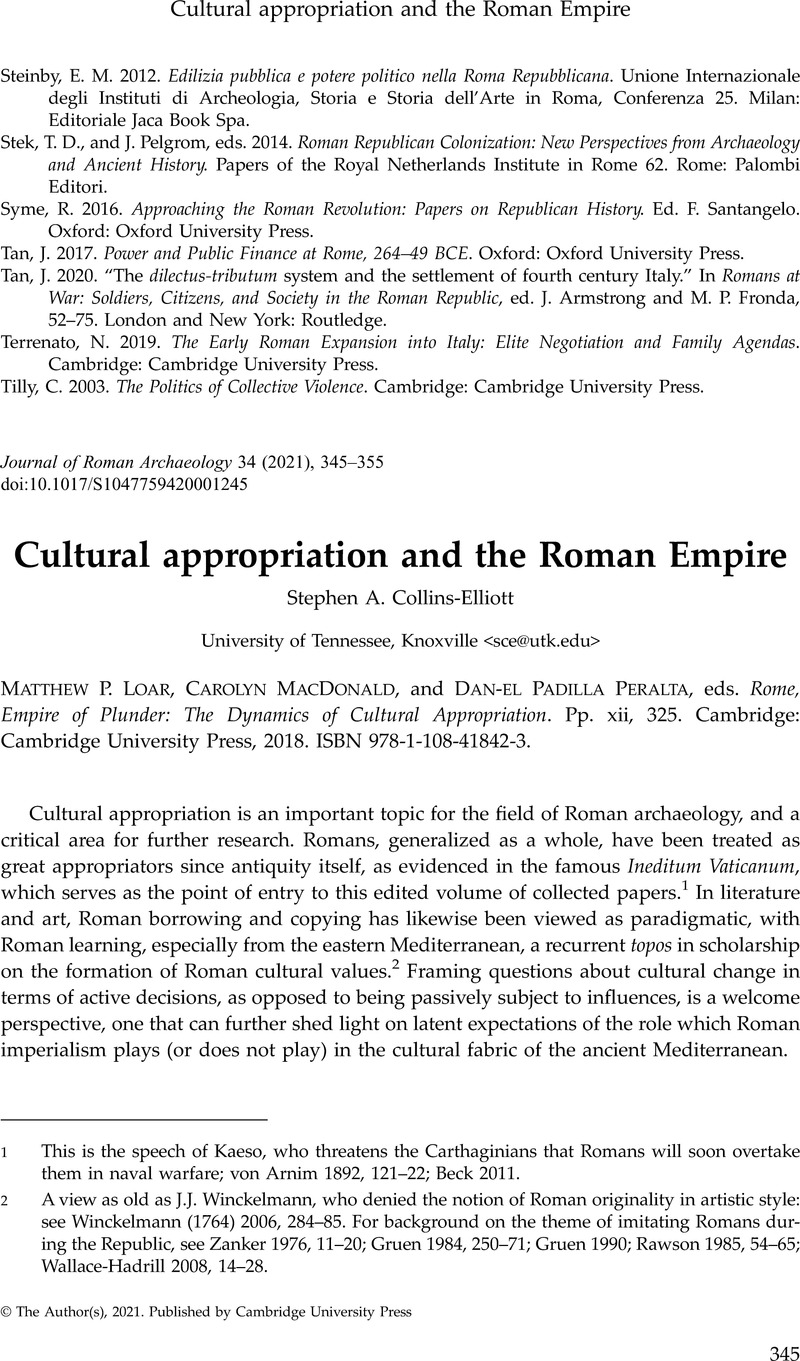No CrossRef data available.
Article contents
Cultural appropriation and the Roman Empire - Matthew P. Loar, Carolyn MacDonald, and Dan-el Padilla Peralta , eds. Rome, Empire of Plunder: The Dynamics of Cultural Appropriation. Pp. xii, 325. Cambridge: Cambridge University Press, 2018. ISBN 978-1-108-41842-3.
Published online by Cambridge University Press: 19 January 2021
Abstract
An abstract is not available for this content so a preview has been provided. Please use the Get access link above for information on how to access this content.

- Type
- Book Review
- Information
- Copyright
- Copyright © The Author(s), 2021. Published by Cambridge University Press.
References
Asega, S, Bhabha, H. K., Bordowitz, G., Kee, J., Kuo, M., Kurian, A., and Satterwhite, J.. 2017. “Cultural appropriation: a roundtable.” ArtForum 55 (10): 266, 268–277. https://www.artforum.com/print/201706/cultural-appropriation-a-roundtable-68677, accessed 1 April 2020.Google Scholar
Ashley, K., and Plesch, V.. 2002. “The cultural processes of ‘appropriation.’” Journal of Medieval and Early Modern Studies 32: 1–15.CrossRefGoogle Scholar
Barbanera, M. 2015. Storia dell'archeologia classica in Italia. Dal 1764 ai giorni nostri. Rome: Laterza.Google Scholar
Barnard, F. M. 2003. Herder on Nationality, Humanity, and History. Montreal and Kingston: McGill-Queen's University Press.Google Scholar
Beck, H. 2011. “Ineditum Vaticanum (839).” In Brill's New Jacoby, ed. Warmington, I.. Leiden: Brill. DOI: 10.1163/1873-5363_bnj_a839.Google Scholar
Bravi, A. 2012. Ornamenta urbis. Opere d'arte greche negli spazi romani. Bari: Edipuglia.Google Scholar
Brilliant, R. 2011. “Authenticity and alienation.” In Reuse Value: Spolia and Appropriation in Art and Architecture, from Constantine to Sherrie Levine, ed. Brilliant, R. and Kinney, D., 67–177. Farnham: Ashgate.Google Scholar
Concannon, C., and Mazurek, L. A., eds. 2016. Across the Corrupting Sea: Post-Braudelian Approaches to the Ancient Eastern Mediterranean. London: Routledge.CrossRefGoogle Scholar
Dawes, K. 1997. “Re-appropriating cultural appropriation.” In Borrowed Power: Essays on Cultural Appropriation, ed. Ziff, B. and Rao, P. V., 109–121. New Brunswick: Rutgers University Press.Google Scholar
de Beer, M. 2006. “Protecting echoes of the past: Intellectual property and expressions of culture.” Canterbury Law Review 12: 94–102.Google Scholar
Deleuze, G. and Guattari, F.. 1987. A Thousand Plateaus. Translated by Massumi, B.. Minneapolis: University of Minnesota Press.Google Scholar
Dench, E. 2005. Romulus’ Asylum: Roman Identities from the Age of Alexander to the Age of Hadrian. Oxford: Oxford University Press.CrossRefGoogle Scholar
Dyson, S. L. 2006. In Pursuit of Ancient Pasts: A History of Classical Archaeology in the Nineteenth and Twentieth Centuries. New Haven: Yale University Press.CrossRefGoogle Scholar
Erskine, A. 2013. “Making sense of the Romans: Polybius and the Greek perspective.” Dialogues d'histoire ancienne, supplément 9: 115–29.CrossRefGoogle Scholar
Farney, G. D. 2007. Ethnic Identity and Aristocratic Competition in Republican Rome. Cambridge: Cambridge University Press.Google Scholar
Giardina, A. 2000. “L'identità incompiuta dell'Italia romana.” in L'Italia romana. Storie di un'identità incompiuta, 3–116. 2nd ed. Rome: Laterza.Google Scholar
Gruen, E. S. 1984. The Hellenistic World and the Coming of Rome. Vol. 1. Berkeley: University of California Press.Google Scholar
Gruen, E. S., ed. 2005. Cultural Borrowings and Ethnic Appropriations in Antiquity. Stuttgart: Franz Steiner.Google Scholar
Horden, P. and Purcell, N.. 2000. The Corrupting Sea: A Study of Mediterranean History. Malden: Blackwell.Google Scholar
Janke, T., and Grant, S.. 2016. Indigenous Cultural Protocols and the Arts. Sydney: Terri Janke & Company Pty Ltd.Google Scholar
Knappett, C., ed. 2013. Network Analysis in Archaeology: New Approaches to Regional Interaction. Oxford: Oxford University Press.CrossRefGoogle Scholar
Levene, D. S. 2010. Livy on the Hannibalic War. Oxford: Oxford University Press.CrossRefGoogle Scholar
Marincola, J. 1997. Authority and Tradition in Ancient Historiography. Cambridge: Cambridge University Press.CrossRefGoogle Scholar
Matthes, E. H. 2016. “Cultural appropriation without cultural essentialism?” Social Theory and Practice 42: 343–66.CrossRefGoogle Scholar
Nelson, R. S. 2003. “Appropriation.” In Critical Terms for Art History, ed. Nelson, R. S. and Shiff, R., 160–73. 2nd ed. Chicago: University of Chicago Press.Google Scholar
New Zealand Intellectual Property Office. 2016. Protecting Intellectual Property with a Māori Cultural Element, accessed 1 October 2020, https://www.iponz.govt.nz/assets/pdf/maori-ip/protecting-ip-with-a-maori-cultural-element.pdf.Google Scholar
Otto, T. 2009. “What happened to cargo cults? Material religions in Melanesia and the West.” Social Analysis 53: 82–102.CrossRefGoogle Scholar
Pitts, M., and Versluys, M. J., eds. 2015. Globalisation and the Roman World: World History, Connectivity, and Material Culture. Cambridge: Cambridge University Press.Google Scholar
Purcell, N., and Horden, P.. 2000. The Corrupting Sea: A Study of Mediterranean History. Oxford: Blackwell.Google Scholar
Rogers, R. A. 2006. “From cultural exchange to transculturation: A review and reconceptualization of cultural appropriation.” Communication Theory 16: 474–503.CrossRefGoogle Scholar
Royal, Te Ahukaramū C. 2007. Mātauranga Māori and Museum Practice: A Discussion. Wellington: Museum of New Zealand Te Papa Tongarewa.Google Scholar
Sauer, E. W., ed. 2004. Archaeology and Ancient History: Breaking down the Boundaries. London: Routledge.CrossRefGoogle Scholar
Scafidi, S. 2005. Who Owns Culture? Appropriation and Authenticity in American Law. New Brunswick: Rutgers University Press.Google Scholar
Sikka, S. 2011. Herder on Humanity and Cultural Difference Enlightened Relativism. Cambridge: Cambridge University Press.CrossRefGoogle Scholar
Spencer, V. 2007. “In defense of Herder on cultural diversity and interaction.” Review of Politics 69: 79–105.CrossRefGoogle Scholar
Telò, M. 2009. “Roman comedy and the poetics of adaptation.” In The Cambridge Companion to Roman Comedy, ed. Dinter, T., 47–65. Cambridge: Cambridge University Press.Google Scholar
Terrenato, N. 2019. The Early Roman Expansion into Italy. Cambridge: Cambridge University Press.CrossRefGoogle Scholar
Trigger, B. G. 1996. A History of Archaeological Thought. 2nd ed. Cambridge: Cambridge University Press.Google Scholar
van Dommelen, P., and Terrenato, N., eds. 2007. Articulating Local Cultures: Power and Identity under the Expanding Roman Republic. Journal of Roman Archaeology Supplement 63. Portsmouth, RI: Journal of Roman Archaeology.Google Scholar
Wallace-Hadrill, A. 2008. Rome's Cultural Revolution. Cambridge: Cambridge University Press.Google Scholar
Winckelmann, J. (1764) 2006. History of the Art of Antiquity. Translated by Mallgrave, H. F.. Los Angeles: Getty Research Institute.Google Scholar
Woolf, G. 2004. “The present state and future scope of Roman archaeology: A comment.” American Journal of Archaeology 108: 417–28.CrossRefGoogle Scholar
Zanker, P. 1976. “Einleitung.” In Hellenismus in Mittelitalien. Kolloquium in Göttingen vom 5. bis 9. Juni 1974, ed. Zanker, P., 11–20. Göttingen: Vandenhoeck und Ruprecht.Google Scholar
Ziff, B., and Rao, P. V., eds. 1997. Borrowed Power: Essays on Cultural Appropriation. New Brunswick: Rutgers University Press.Google Scholar


